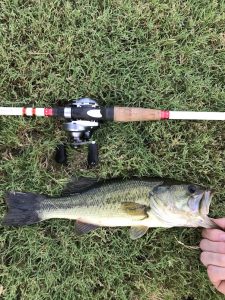TCA Blog Entry #1
This semester, I decided that I would be doing my observations on the population, type, and activity of fish in Towne Lake. Growing up as an angler, I have always enjoyed fishing but have obviously been discouraged when I fail to catch a fish on a particular day. Because of this, I have always wondered “How come some days the fish bite and other days there seem to be no fish in the entire lake?” I figured that if I could answer this question, thus allowing me to determine the best, most opportune times to fish, I could maximize the amount of fish I would catch. To begin, I would first like to talk about the main two types of fish that I fish for in the Austin area. Those two types are Largemouth Bass and Channel Catfish. Now, both of these types of fish are very prominent in Towne Lake, but it was clear from the beginning that I was not going to catch them at all times of the day, month, or year. This is what prompted me to begin my observations.
I want to begin first with my observations of Largemouth Bass. It is a fairly well known fact among the bass fishing community that Texas summers are guaranteed to slow down the overall amount of fish because of the rising water temperatures, therefore, to continue to catch fish in the summer, most fishermen believe that you must fish during the cooler parts of the day. These parts include early in the morning and just before sundown. These are also the times that most fish feed making those times much more lucrative options. To test this theory, I began fishing on the morning of Sunday, October 1st, around 6:45 am. The temperature was roughly 74 degrees when I began but I knew it was going to rise quickly as the sun came out. I found that the entire time the temperature was below 83 degrees, I was able to see Largemouth Bass searching for food near the top of the water. Because of this, I was able to sight fish. Sight fishing is very important because rather than blindly casting into an area I think may have fish, I can cast to an area I know has fish because I can literally see them! Just as I suspected though, as the temperature surpassed 85 degrees, all of the fish began to disappear, retreating to the deeper, cooler water thus making it much harder to pinpoint the higher population areas.
Next, I would like to discuss my observations of catfish at Towne Lake. Fishing for catfish is much different than fishing for bass. Most people may not know that catfish are almost totally blind and operate almost solely by smell. This makes them fairly easy to catch, if fishing correctly. Because catfish are almost completely blind, it is very important to fish for them when visibility is low so they have to rely completely on their sense of smell. This is why, when fishing for catfish, anglers use bait that has a very strong smell to lure catfish to them, and having them bite without seeing. To test this, I began fishing for catfish at 12:30 pm on Sunday, October 1st. Although I did get one bite, the fish did not commit enough for me to set the hook and I was left empty handed. Fortunately, I returned to the same spot at roughly 7:30 pm that night. At that time, I ran one line with the same type of bait and within two hours, I caught 3 catfish (all of which I released back into the lake).
These observations have confirmed and strengthened my fishing philosophies and techniques and allowed me to improve my fishing ability. Moving forward, I plan on observing the fish activity as the temperature begins to steeply decline into the fall and winter. Will I be able to fish for bass later in the day due to the lower temperatures? Will the temperature effect the catfish activity in anyway? Find out on my next blog post!
APA Bibliography
Staples, B. (2000, June 14). BassResource.com. Retrieved October 10, 2017, from https://www.bassresource.com/fishing/summer_bass_fishing_tips.html
THE BEHAVIOR AND HABITS. (n.d.). Retrieved October 10, 2017, from http://www.umpquavalleybassmasters.com/bassbook.htm

